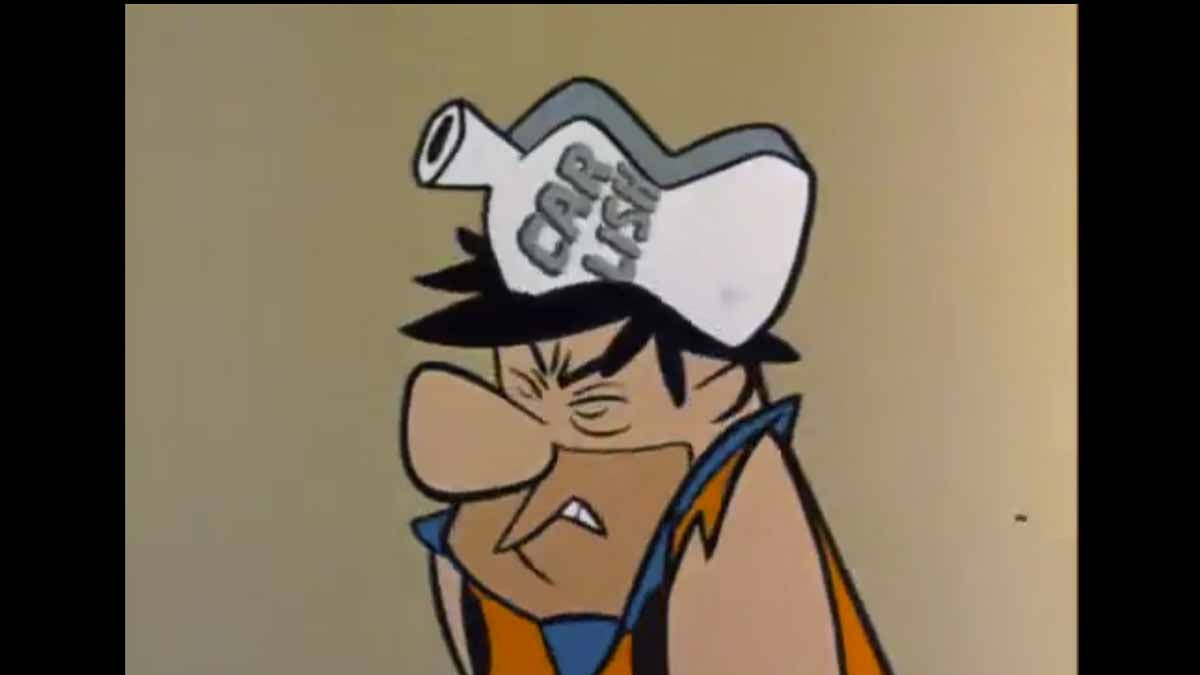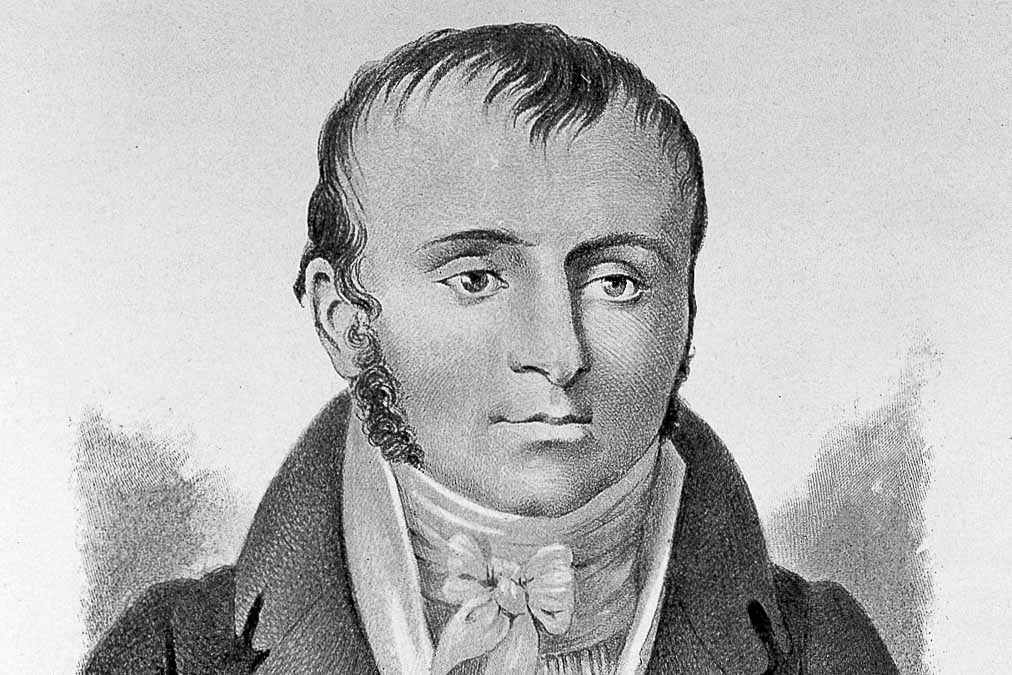Fact or cartoon fiction: Can the ‘double conk’ cure amnesia?
Listen 9:27
In season 1 episode 5 of The Flintstones, Fred gets conked on the head (as pictured here) and it completely changes his personality. A second conk later on reverses it. (Screen grab of The Flintstones)
Mary Spiers runs the website neuropsyfi.com, which is devoted to how brain science is depicted in movies. So, if a film touches on dementia or autism or stroke, Spiers will review it, and rate how accurate the character’s symptoms or condition is portrayed.
Spiers is qualified for the role: she’s a licensed clinical psychologist, and a professor at Drexel University, where her students also contribute to the site.
She’s seen and thought a lot about these types of films, as well as common misperceptions about brain science and injuries. There’s this one particular storyline, though, that still leaves Spiers stumped.
“You get conked on the head, and then lose your memory, and then maybe get conked on the head or have some kind of emotional jolt to bring you back,” she says.
For lack of a better term, Spiers calls this scenario ‘the Double Conk.’ The first blow, usually physical, arrives in Act 1, creating a character who forgets who she is, or where she is from. Then, later in the film, a second blow arrives, potentially a familiar song or photograph, or, again, a conk on the head, and it all snaps back into place for our protagonist.
The ‘Double Conk’ shapes the story arc for the 2001 Jim Carrey film The Majestic, along with the 1956 black-and-white film Singing in the Dark. It shows up in an early Tarzan movie, a Tom and Jerry feature, and numerous times in silent films. And of course, it is all over sitcoms and cartoons, including Gilligan’s Island, I Dream of Jeanie, and The Flintstones.
Clearly, somewhere, there is a studio executive who really likes this idea. But for Spiers, this concept is sort of a head scratcher.
“It’s really neurologically bizarre,” she says. “And so, I wondered where it started, where it came from?”
Left brain, right brain
Spiers starts digging back, attempting to find the origins of the Double Conk. And it turns out, it doesn’t just live on screen. It shows up in plots written just after the Civil War, and in Victorian-era stories. She keeps searching, and eventually traces it back not to a writer or a novelist, but to a medical professional.
“There was a man in the early 1800s, his name was Bichat, a French doctor.”
His full name was Marie Francois Xavier Bichat, an anatomist and surgeon born in 1771. In portraits, he’s a handsome-looking guy, thinning hair, mutton chops, with a serious demeanor.

“Mostly he just seems to spend a lot of time as a diligent student, and then as an extraordinary researcher, and just a lot of hands on time cutting up bodies,” says Jonathan Strauss, a professor of French at Miami University in Ohio, where he’s written about Bichat’s contribution to medicine, and his passion for dissection.
“[In] the winter of 1800, he opened up 600 cadavers. And he did human beings, and he also did a lot of work on stray dogs, I’m sorry to say.”
This guy was not well regarded by French canines. But he was pretty famous in medical circles, even early in his career. And that’s for two reasons–the first, he was doing what was, at the time, pretty novel research on organs and how cells join together to form tissue. And second, Bichat was popular because he did a really nice job explaining his theories.
“He’s a very clear writer. He has Mozartean clarity and poise and balance to his writing,” says Strauss. “People could make sense of him.”
Right around the turn of the century, Bichat uses those skills to write a book titled, in English, Physiological Researches Upon Life and Death.
And it is in that book that Mary Spiers finds what she’s been looking for, the origins of the Double Conk.
“Bichat thought that if you got hit in the head, that you would be out of balance, so there was this idea of symmetry,” she says.
Bichat spells out his theory that the two halves of the brain, the left brain and right brain, work in a careful balance. They’re partners. Therefore, if one side of the brain is somehow injured, it throws off the functioning of the entire unit. He writes that the two sides, “cannot be different in their mode of acting.”
“He doesn’t use this example,” says Strauss, “but it is sort of like the gears of a machine getting out of alignment. And so instead of complimenting each other, they are going to be interfering with each other.”
Bichat’s belief in this symmetry therefore held that if you damaged one side of the brain, well, you needed to damage the other side to restore harmony. Trouble is, he doesn’t provide any evidence to support this concept.
“My suspicion is that this was something that was just fairly common, in terms of ideas,” says Spiers. “And he was just using evidence that he thought everybody already knew about.”
Curiously, for a man so dedicated to science and dissection and proof, Bichat fails to offer any. Instead, he simply writes about how frequently this method of restoring brain function is reported as working.
He’s simply pulling from popular culture, from anonymous stories and anecdotes. Turns out, Bichat isn’t the origin of the Double Conk. He just gets credit for being the first to put the thing down in writing, as least as far as Mary Spiers can tell.
He was so wrong, though, about how the brain works and what could cure it, perhaps ‘credit’ shouldn’t be awarded.
“Oh, you wouldn’t be the first to discredit him. Get in line,” jokes Strauss. He says by the fourth edition of the book, about 20 years after its first publication, his editors had disavowed the entire brain symmetry/Double Conk argument.
Science had moved on to other theories about how the brain functioned.
The ghost of you lingers
But that opens up an interesting question. If the medical establishment was willing to leave the Double Conk behind in the 19th century, why won’t fiction writers?
“I think because it has such dramatic potential, and it can make your characters do things that they wouldn’t normally do. It can put them in situations that they wouldn’t normally be in, and we the audience can be in on it,” says Sallie Baxendale, a neuropsychologist at University College London, who has written about amnesia in the movies.
“So we know things that the characters don’t know, and that combination is really seductive for filmmakers, and it is entertaining. It really works.”
A tool for the lazy writer, perhaps?
Looking beyond the double conk, Baxendale says it is frustrating to see memory loss so often inaccurately portrayed on screen.
“What you find in the movies, time and time again, is that somebody will get a very nasty bang on the head, and have absolutely no difficulties creating new memories, but they’ll lose who they are,” she says. “They’ll lose all access to any information from the past…which doesn’t make any sense neurologically because we just don’t see that in patients.”
For the vast majority of people with head injury, Baxendale says learning new skills and forming new memories are the harder tasks, not remembering who you are or where you’re from.
Bichat, of course, isn’t around to atone for his mistakes, though he is still hailed in France for his scientific achievements. In fact, he’s one of 72 names inscribed on the Eiffel Tower.
And the end of his story, well, it would be a bit dark for Hollywood’s tastes. Spiers explains “he died at a young age, and ironically, we think, do to a head injury.”
“A cerebral hemorrhage of some sort,” adds Strauss. “I think he was in the school of medicine, he stumbled on the stairs, fell on the stairs, hit his head. Only once, which may have been the problem, and subsequently died.”
A single conk, at the age of 30. A life cut short well before the credits rolled.
WHYY is your source for fact-based, in-depth journalism and information. As a nonprofit organization, we rely on financial support from readers like you. Please give today.






